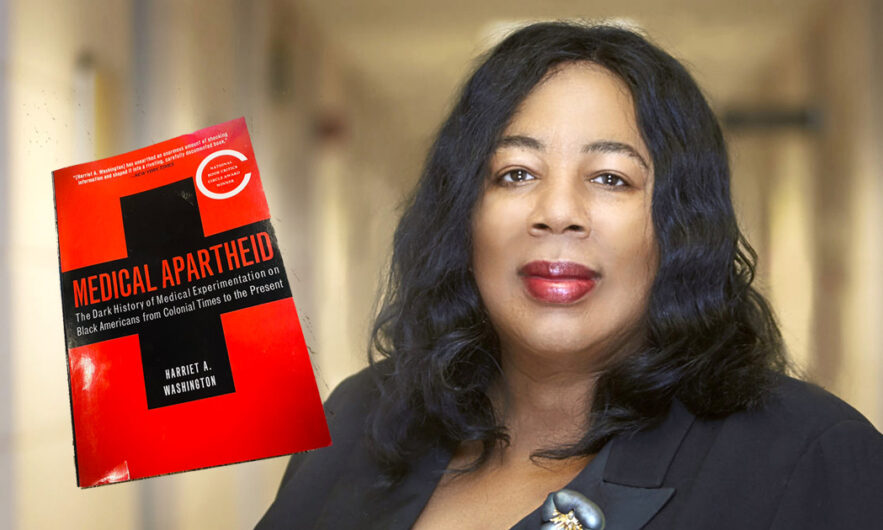Medical Apartheid opens with Harriet A. Washington unearthing a pair of folders in her office, a poison-control center at a teaching hospital in New York. She was in the middle of moving offices, and found two forgotten folders from a colleague, a physician she had admired and who encouraged her medical career.
The first patient’s file was thick, and it was marked that the patient had “imminent kidney failure.” The documentation noted tests, the search for a kidney transplant, and a social history that stressed “his loving family and his determination to live.” The second folder was thin, though it too was from a patient with imminent kidney failure. However, it instead noted simply that he was retired, insured, and “negro”.
There were no tests in this thinner folder, no search for a kidney donor, but just a line noting to help him plan for his “imminent demise.” The files were from the 1970s. When Washington asked around, not wholly convinced this colleague she admired so much would just not do a kidney donation search based on the patient’s race, what she found was just the start of her journey. A friend at the same hospital tells her, “black people give organs, they don’t get them.”
A celebrated health ethicist and journalist, Washington has been a fellow in ethics at Harvard Medical School, a senior research scholar at the National Center for Bioethics at Tuskegee University, a fellow at Harvard School of Public Health, and a journalist with a Knight Fellowship at Stanford University. Published in 2006, “Medical Apartheid” won the National Book Critics Circle Award, and its lessons are still relevant today. Washington traces the history of racism in medicine from the Civil War through recent AIDS vaccine research, and explains how racist traditions still inform some medical practice today.
This book is challenging to get through. In “Medical Apartheid: The Dark History of Medical Experimentation on Black Americans from Colonial Times to the Present,” African American health ethicist Harriet A. Washington painstakingly lays out a broad history of abusive experimentation of African Americans at the hand of the “medical establishment.”
“Medical Apartheid” is a huge book that covers centuries of history that is galling, yet told with such engaging storytelling that I found it very difficult to stop reading, even when the subject matter was harrowing. It is a necessary book that shines a light on just how today’s health disparities came to be. And in that journey, like all good history books, maybe we can learn from it in order to change how we live today.
MedShadow and Pharmacovigilance
The role of health equity in pharmacovigilance (drug safety) is one that resonates with many today. Pharmacovigilance, as defined by the World Health Organization, “is the science and activities relating to the detection, assessment, understanding, and prevention of adverse effects or any other medicine-vaccine-related problem. All medicines and vaccines undergo rigorous testing for safety and efficacy through clinical trials before they are authorized for use.” Pharmacovigilance remains a centerpiece in “MedShadow’s” mission, and health equity is one of pharmacovigilance’s foundations. “Medical Apartheid” underscores the importance of understanding the history of racism in medical research on African Americans and its impact.
“I finally glimpsed that understanding the true extent of unethical medical research with African Americans was more than idle curiosity of an academic exercise: It was key to removing barriers between African Americans and the bounty of the American health-care system,” Washington writes.
Medical Experimentation on Black Americans, A Timeline
“Medical Apartheid” is written largely in chronological order, from the era of slavery in the 1700s until “present day” research issues, although keep in mind the book was published in 2006. The book is broken up into four sections: Part 1, “A Troubling Tradition”, is an early historical timeline on the role of African Americans in American medicine, from before the Civil War until the Tuskegee Syphilis Study (1932). Part 2 “The Usual Suspects”, covers the early 20th century until the present day (2006). However it delves deeper into the vulnerable subjects of children, hospital patients, soldiers, and the larger governmental and corporate institutions. Part 3, “Race, Technology, and Medicine,” examines challenges in achieving health equity in medical research today. And Washington ends with an epilogue, threading overall lessons learned throughout this history, and finally presenting some ideas on how we move forward.
Without Consent, From the Enslaved to Tuskegee
In one scene in Part 1, Sam, an enslaved 42-year-old man from an Alabama plantation, is racked with so much pain in his jaw that he was unable to work at times. The slave owner thought Sam had syphilis, and gave him a homemade remedy that caused boils on his gums. This misdiagnosis meant Sam remained in such agonizing pain that he was still unable to work the fields. The owner sent Sam to a doctor, who diagnosed him with cancer of the jaw and referred him to a surgeon, Dr. Marion Sims, who told the slave owner that the only cure was an operation. The x-ray wasn’t invented until 1895, so it was impossible for physicians to see the internal body without invasive surgery. There was no anesthesia, antiseptics, or antibiotics. Sam tried to refuse surgery, but it was not his decision. His owner wanted his labor, and he was sent for surgery.
Dr. Sims performed the surgery in an operating theater in front of students. With Sam strapped down on four wooden boards, Dr. Sims proceeded to remove his lower jawbone. The operation was lauded as a success in the New Orleans Medical and Surgical Journal, but Washington clarifies that the patient’s willingness to participate or desired outcome was not something the experts considered important to that analysis. Slaves were nearly all, if not completely all, “clinical material.” They were forced to undergo medical experiments and even experimental surgery, all without their consent. Dr. Sims would go on to invent what is now known as the speculum, and become “the father of gynecology” using enslaved women as subjects in his excruciating and humiliating experiments.
Part 1 ends with the well-known and -documented 1932 untreated syphilis study, dubbed the “Tuskegee Study” that experimented on 600 black men, without their known consent. Additionally, when penicillin is discovered as a treatment for syphilis, it is not offered to the participants for the remaining 25 years of the study
Men in the study were told only that the study was on “bad blood,” that they would receive free medical care, meals, and burials. They did not know they were being experimented on, or even that if they tested positive for an STD, or that they could be infecting others even while being “treated.”
Washington elaborates on the whys of it, hitting on everything from Hannah Arendt’s “banality of evil,” to an eventual united black and white outrage. Washington struggles to understand how and why experiments like this could ever have happened, but eventually she concludes that, “the greatest tragedy of the [Tuskegee] study is that it has failed to serve as a cautionary tale for researchers. Its inception marked the dawn of many other experimental evils against blacks, detailed in the chapters to come.”
Medical Racism From the 20th Century to Today
As we move into the 20th century in Part 2, we see how medical racism remains in our most vulnerable communities, and at times at the hands of the very both public and private institutions that should be protecting us. One of these chapters covers the 1992 to 1997 studies co-led by New York City’s New York State Psychiatric Institute (NYSPI) and Columbia University’s Lowenstein Center for the Study and Prevention of Childhood Disruptive Behavior Disorders that sought to research if there were links between genetics and violence.
Researchers knocked on doors in underserved Black neighborhoods to recruit children they hoped would participate in a study linking genes to violence. They told the parents the study would include a simple interview, one overnight stay at a hospital, harmless medication, and a free, safe test to see if your child has any harmful medical issues. It was vague and also appealing, with an offer of $100 and a gift certificate to Toys ‘R’ Us to sweeten the deal.
Thinking that certain genes might influence levels of a chemical in the brain, called serotonin, and that that might be a cause for violent behavior, the researchers performed experiments on at least 126 boys, ages 6 to 10, with fenfluramine, a drug that mimics serotonin in the brain. Today it’s used to treat rare types of seizures and is known to cause heart problems, particularly at high doses. The boys were all Black, had older brothers on probation, and Washington claims the experiment specifically excluded whites from participating. Later, in 2004, a study implicated a low single dose of fenfluramine in brain damage, and may actually trigger behavior changes such as increased aggression.
Recalling her son’s participation in the study, Charisse Johnson is quoted describing side effects of fenfluramine on her son: sharp headaches, anxiety attacks, and struggling to breathe as though having an asthma attack. A month before they were given the fenfluramine, participants were withdrawn from all prescribed medicine, including life saving medications like those for asthma. Additionally, they were deprived of food during the duration of the experiment at the hospital, and deprived of water the next day.
At 8:30 a.m. after the hospital overnight, doctors inserted a catheter and the boys were given fenfluramine hydrochloride orally. Despite complaints that ranged from lightheadedness to severe headaches, the boys were not released. Blood was drawn on the hour. This correlation between aggression and serotonin has since been widely criticized, with Washington going on to eviscerate the evidence of scientific errors and ethical lapses. Washington then describes more and more egregious examples of unethical studies like this one. Readers are left to wonder how to bridge the gap between the abusive history of the past and the potentially life-saving research of today.
Race and Medicine Today
In one chapter in Part 3, “Infection and Inequity,” Washington explores stories of Black patients “jailed” in hospitals, shackled to beds, and administered medication under the observation of not doctors, but deputies. With stories that touch on everything from containment therapy, to tuberculosis, to AIDS, Washington stresses the racial disparity in examples, such as the forced medical treatment of African Americans versus white Americans and how legal provisions being followed, especially regarding forced medical care, vary by race. Patients subject to such a form of medical incarceration are found in cities from New York, Boston, Atlanta, DC, and others according to Washington.
Part 3, for me, read as the most dated. Many theoretical questions she poses, such as how would an epidemic or pandemic exacerbate structural racism in the medical establishment, and would access to vaccines and health care and treatments reach the African American community, have since been answered during COVID. Knowing what we know now, thanks to COVID 19, we still have plenty to learn from “Medical Apartheid.”
At other times, I found Washington’s examples to have too small a sample. For instance, to illustrate racial disparity in containment therapy, Washington noted statistics that spanned 1988 to 1991, a period in which 33 tuberculosis patients were held against their will until they were no longer infectious. Here 79% of these held patients were Black. A greater dive into what containment therapy was, and a larger statistical pool than 33 TB patients, would have given the racial disparity percentage more weight.
Toward the end of the book, in the infection and inequity sections, Washington hits upon both AIDS and TB, and shows us that African American patients may find themselves involuntary research subjects. GlaxoSmithKline, for one example, the manufacturer of zidovudine, has sponsored testing antiretrovirals and other pharmaceuticals on HIV infected orphans, children in New York City’s Incarcerated Children’s Center (ICC) four times between 1997-2003.
In another section Washington shares a vaccine trial for AIDSVAX that shows more impact on Black and Asian patients, but none on white, and consequently abandoned as a failure. In 2003, the drug AIDSVAX was the first vaccine to enter Phase 3 drug trials, and cut infection rates in Blacks by 68 percent, but no statistical difference in whites. The racial discrepancy was looked at by a team of researchers from the National Institutes of Health (NIH), Centers for Disease Control and Prevention (CDC), and University of Washington, led by Dr. Dean Follman (NIH).
The team re-analyzed the data and concluded that 22 percent of the time a significant result from one of the fifteen subgroups could happen by chance, contradicting VaxGen’s claim of a two percent chance. Washington says that, because of the Follman study, in the end, the Food and Drug Administration denied Phase 3 testing.
Washington writes, “These experts may well be right and the vaccine’s hoped-for-effectiveness against HIV in black and Asian segments of the population may be chimerical, a mere statistical mirage. But there is room for doubt, and it is important medically and socially to commission more exhaustive studies before deciding that the benefits are illusory.”
The epilogue, “Medical Research with Blacks Today,” dives into how the most appalling abuses of the past must be acknowledged “in order to regain trust and seize the future.” She asks that readers understand both the history of past medical racism, and also embrace the necessity of greater participation of African Americans in medical research today.
Medical Apartheid is not an easy book to get through, but it remains essential. Racism in health and U.S. medicine has not gone away, and there are those committed to addressing it, from the academic arena, to clinical trials, to the personal patient stories. But there is more to do. The overall lessons of Medical Apartheid remain timely. It is by acknowledging the historical facts of centuries of medical abuse of African Americans, and by holding our medical institutions accountable with lessons learned on racism in medicine, that health equity can ultimately deliver life-saving research for all.






